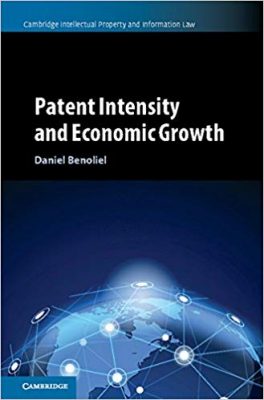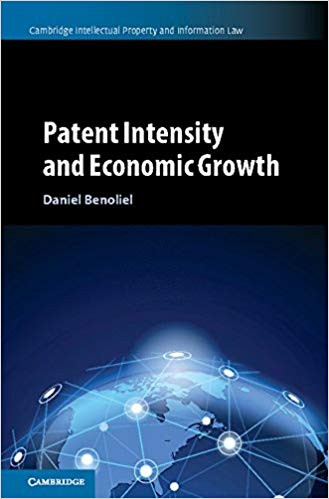 Author: Daniel Benoliel
Author: Daniel Benoliel
Publisher: Cambridge University Press – 406 pages
Book Review by: Sonu Chandiram
It has been traditionally assumed by economists that technological innovation within countries (as measured by an increase in patent registrations) leads to increases in production output that boosts economic growth.
But some uncertainty exists on whether there is a direct relationship between an increase in patents and an acceleration of gross domestic product (GDP), particularly when looking at emerging countries versus developed ones, as the author Daniel Benoliel writes in his Introduction.
He points out: “In the past developing countries were thought to be at an earlier phase along a linear path of historical technological catch-up by comparison with more developed countries. This course also underlined the neoclassical economics inclination toward ‘one-size-fits-all’ patent policies toward fostering innovation-based economic growth.” Then he cites several world economic bodies whose policies are based on such growth-in-patents initiatives.
Among them are the World Trade Organization (WTO), the World Intellectual Property Organization (WIPO), the Trade-Related Aspects of Intellectual Property (TRIPS), and the World Health Organization (WHO).
This book examines the relationship between patents and economic growth in three types of countries, and presents its findings. We provide to you an outline of that relationship examination by listing below the six chapters of this book:
Introduction
- Setting the Framework: Patenting and Economic Growth Policy
- Convergence Clubs, Coalitions and Innovation Gaps
- Institutions, Gross Expenditure on Research and Development (GERD) Intensity, and Patent Clusters
- GERD By Type, Patenting, and Innovation
- Patent Intensity by Employment and Human Resources
- Special Agglomeration of Innovation and Patents
General Conclusion
There are many outstanding concerns and differences between developed and developing countries on the right way to bring about economic growth and development. These are part of the broader North-South debate, the North representing the developed world and the South consisting of developing (sometimes termed ‘emerging’) economies.
Some endogenous economic-growth proponents have said that harmonization of patents across countries is essential, but the author of this book has joined the dissenters of this hegemonic approach. Among other points that Benoliel makes on this issue, he argues patent harmonization among countries is
- Not clearly necessary
- Not empirically-based
- Not otherwise adequate for the South (developing countries)
In chapter 1, Setting the Framework: Patenting and Economic Growth Policy, Benoliel notes: “Economists have traditionally perceived patents as a vital lever through which policy-making affects innovation-based economic growth,” citing authors Richard Gilbert and Carl Shapiro of an article entitled Optimal Patent Length and Breadth in the Rand Journal of Economics (vol. 21, 106 (1990).
But the evidence shows otherwise. Benoliel asserts: “Yet across different countries the precise effect of patents remains uneven, for two fundamental reasons. These two reasons relate to the ambiguous effect of national patent laws upon their enforcement, and to the ambiguity associated with the impact patenting rates have on economic growth
The are other reasons why endogenous-growth economics continue to present challenges, and some of them are discussed by Benoliel in chapter 2, Convergence Clubs, Coalitions, and Innovation Gaps.
Proponents of the endogenous growth approach to achieving widespread economic growth worldwide suggested forming ‘country groups’ or ‘convergence clubs’ consisting of members with similar demographics, such as for example GDP, salary levels, or other macroeconomic income-related factors. But Benoliel asserts that does not make sense.
He writes: “There is little understanding of the reasons for the convergence between country groups or clubs in terms of domestic technology creation, and not much more is known about how club convergence is achieved through the diffusion of technology through technological transfer to developing countries.”
The endogenous growth proponents also suggest that developing countries grow the number of patents issued domestically by growing expenditure in research and development (GERD). In chapter 3 – Institutions, GERD Intensity, and Patent Clusters – the author offers “an empirical and theoretical critique of the impact of institutions on patent intensity across countries.”
One of the elements for spurring development, the endogenous economics espousers suggest, is to boost research-and-development (R&D) spending, particularly international R&D by multinational companies (MNCs).
But the evidence shows that it is mainly the developed countries’ multinational firms that are introducing new technologies into developing nations. The author cites as examples, the initiatives of General Electric across India, and Motorola’s building of the first foreign-owned research-and-development lab in China.
This is an eye-opening, fact-based book on what ideas and initiatives on economic growth work, and what do not, in developed as well as in developing countries, particularly as they relate to innovation and technology.
Author:
Daniel Benoliel is a law professor at the University of Haifa Faculty of Law, and Haifa Center of Law and Technology (HCLT). His main fields of expertise include international intellectual property, patent law and innovation, public international law, and entrepreneurship law. Benoliel holds a Doctorate in law (JSD) from the University of California Berkeley School of Law. He is a Visiting Fellow alumnus of Yale Law School, and has engaged in an Information Society Project (ISP) there. He has received numerous prizes, awards, and research grants in these fields.







